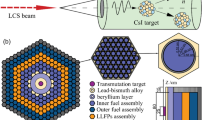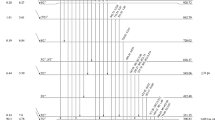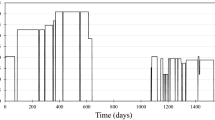Abstract
The properties of potential nuclear waste forms have been under investigation for more than a decade to ensure their safe handling, packaging, transport, storage, and disposal. Two kinds of high-level radioactive waste (HLW) have received most attention: (1) that which could be produced from reprocessed commercial reactor fuel, and (2) the slightly less radioactive waste from military activities. Both kinds would be converted to solid, nondispersible forms such as glass or crystalline ceramics for disposal. After disposal, self-radiation damage, primarily radiation-induced atomic displacements, can change the properties of these waste forms and possibly increase the chances that radioactivity could be released to the environment. β decay of the fission products causes some displacements but α decay, and the associated recoil nuclei, of the actinide elements produces several orders of magnitude more displacements. Most recent studies on radiation effects have therefore concentrated on α decay1–3. A potentially more important aspect of β decay is the associated transmutation of fission products which usually results in changes of both valence and ionic size, both of which may not be readily accommodated by HLW solids. 137Cs and 90Sr are the two main sources of transmutations, but they have not been studied because of their ∼30-yr half lives. The problem has now been circumvented by preparing simulated waste forms and other solids containing 134Cs, which has only a 2-yr half life. This study will not be completed for at least another year, but we report here that results obtained after 2 yr of decay are encouraging in that negligible changes have been observed in the properties of all the materials studied.
This is a preview of subscription content, access via your institution
Access options
Subscribe to this journal
Receive 51 print issues and online access
$199.00 per year
only $3.90 per issue
Buy this article
- Purchase on Springer Link
- Instant access to full article PDF
Prices may be subject to local taxes which are calculated during checkout
Similar content being viewed by others
References
Mendel, J. E. et al. A State-of-the-Art Review of Materials Properties of Nuclear Waste Forms PNL-3802, Pacific Northwest Laboratory, Richland (1981).
Roberts, F. P., Turcotte, R. P. & Weber, W. J. Materials Characterization Center Workshop on the Irradiation Effects in Nuclear Waste Forms (PNL-3588, Pacific Northwest Laboratory, Richland, 1981).
Permar, P. H. & McDonnell, W. R. Proc. 10th int. Symp. on Effects of Radiation on Materials (eds Kramer, D., Bragen, H. R. & Perrin, J. S.) 115–141 (ASTM-04-725000-35, 1981).
Author information
Authors and Affiliations
Rights and permissions
About this article
Cite this article
Gray, W. Fission product transmutation effects on high-level radioactive waste forms. Nature 296, 547–549 (1982). https://doi.org/10.1038/296547a0
Received:
Accepted:
Published:
Issue Date:
DOI: https://doi.org/10.1038/296547a0
This article is cited by
-
Concept of a fast breeder reactor to transmute MAs and LLFPs
Scientific Reports (2021)
-
Study on method to achieve high transmutation of LLFP using fast reactor
Scientific Reports (2019)
-
Simulation of radioactive decay by barium substitution for cesium in sodium aluminum-iron phosphate glass
Journal of Radioanalytical and Nuclear Chemistry (2019)
-
Method to Reduce Long-lived Fission Products by Nuclear Transmutations with Fast Spectrum Reactors
Scientific Reports (2017)
Comments
By submitting a comment you agree to abide by our Terms and Community Guidelines. If you find something abusive or that does not comply with our terms or guidelines please flag it as inappropriate.



